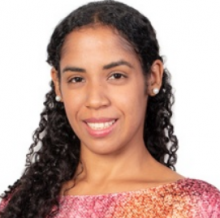
Julieth Irene Murillo Silva
PhD studentJulieth is a biologist who during her undergraduate thesis applied bioinformatics tools for looking for structural patterns taxonomy related, at the genomic region 5’ UTR of viruses belonging to the Potyviridae family. Julieth worked at the laboratory of virology at CIAT, where she was trained in the molecular diagnosis of plant viruses and in the genome sequence analysis of Rice hoja blanca viruses with taxonomy purposes. Later, she joined the Cutaneous Leishmaniasis (CL) team at CIDEIM in Colombia, an internationally-known infectious disease research centre and WHO reference centre for leishmaniasis. Here, as a Young Investigator supported by COLCIENCIAS and the Fogarty GID grant, she used candidate gene selection approach, to select human genetic variants with potential function as biomarkers of the clinical outcome in patients with CL. Currently, as an Engineering PhD student at Javeriana University-Cali and co-advised by Dr. Maria Adelaida Gomez, her research blends biological and computational approaches to understanding cellular mechanisms that drive non-healing and healing responses in the same disease.
Project summary
Cutaneous Leishmaniasis (CL) is an immune-mediated skin pathology, caused by the intracellular parasites Leishmania. In the absence of treatment, the host can either self-resolve (SR) or develop chronic cutaneous lesions (CCL). Similarly, upon chemotherapy, patients can cure and in close to 30% of cases fail to adequately respond to treatment. Resolution of infection in the absence or presence of chemotherapy is intimately linked to the host response. However, the common (backbone) mechanisms elicited in healing and non-healing responses remain unknown. By using the systematic way of curation of Reactome the goal is to identify key immunobiological pathways that take place during healing and non-healing responses.
